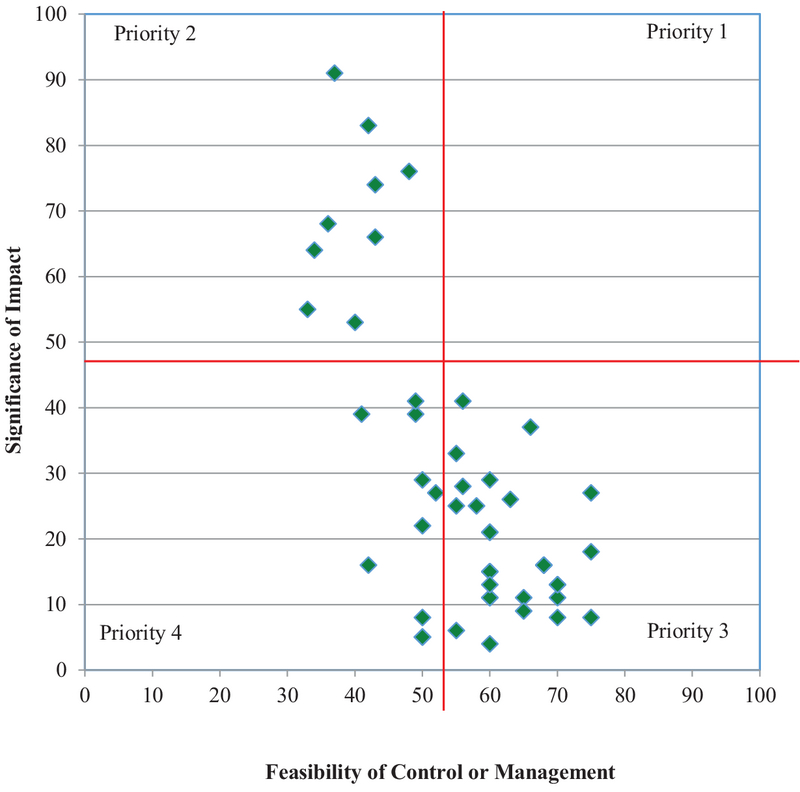Determination Of Priority Species For Invasive Plant Management In Wetlands Of Wasur National Park Merauke
DOI:
https://doi.org/10.18502/kss.v1i1.431Abstract
Threats on biodiversity in a conservation area can originated from outside or inside the area. One of the outsiders that rarely noticeable is invasion of exotic species, which usually alters the stability of natural processes within the area. Wasur National Park has some wetland ecosystems that overcome the issues of deterioration in function and benefits due to exotic plant invasion in recent days. This research was carried out to determine priority species that need immediately managements in Wasur National Park. Field survey and inventory followed by scoring and evaluation methods using Weed Risk Assessment by Exotic Species Ranking System were taken in this research to obtain the priority species. The scoring and ranking steps placed encountered invasive plant species into four categories of management priority based on Significance of Impact and the Feasibility of Control. The result identified 49 species of invasive plants from three wetlands in Wasur National Park, which 75% (or 36 species) of them are species of Priority 3 (lesser threat and easy to control), 4 species of Priority 4 (lesser threat – hard to control) and at least 9 species of Priority 2 (serious threat-hard to control). Priority 2 species consist of Carex sp., Eleocharis indica (Lour.) Druce, Hanguana malayana (Jack.) Merr., Imperata cylindrica (L.) Beauv., Ludwigia oktovalvis (Jacq.) Raven, Melaleuca cajuputi Powell, M. leucadendron (Linn.), Paspalum conjugatum P. J. Bergius, and Stachytareta jamaicensis (L.). These invasive plants need to be managed properly and thoroughly further.
Keywords: invasive plant, management priority, Wasur National Park
References
K. J. Benke, J. L. Steel, and J. W. Weiss, Risk assessment models for invasive species: uncertainty in rankings from multi-criteria analysis, Biol Invasions, 13, 239–253, (2011).
BIOTROP, www.biotrop.org/database, (2011).
CABI, Invasive Species Compendium www.cabi.org/isc, (2011).
E. Caesariantika, T. Kondo, and N. Nobukazu, Impact of Acacia nilotica (L.) Willd. ex. Del invasion on plant species diversity in the Bekol Savanna, Baluran National Park, East Java, Indonesia, Tropics, 20, 45–53, (2011).
P. D. Champions and J. S. Clayton, A weed risk assessment model for aquatic weeds in New Zealand, in Weed Risk Assessment, R. H. Groves, D. F. Panetta, and J. G. Virtue, Eds., 194–202, CSIRO Publishing, Collingwood, VIC, 2001.
P. O. Downey and A. C. Grice, Determination and management of the impacts of weeds on biodiversity, Sixteenth Australian Weeds Conference, 23–25, (2008).
P. O. Downey, S. B. Johnson, J. G. Virtue, and P. A. Williams, Assessing risk across the spectrum of weed management. CAB Reviews: Perspectives in Agriculture, Veerinary Science, Nutr Nat Resour, 5, 1–15, (2010).
L. C. Foxcroft and P. O. Downey, in Protecting biodiversity by managing alien plants in national parks: perspectives from South Africa and Australia, 387–403, Backhuys Publishers, Leiden, The Netherlands, 2008, T.-G. B, J. H. Brock, G. C. Brundu, D. C. C, and P. Pysek, Plant Invasions: Human perception, ecological impacts and management.
I. S. Group, Global Invasive Species Database www.issg.org, (2001).
Weed Risk Assessment, R. H. Groves, D. F. Panetta, and J. G. Virtue, Eds., CSIRO Publishing, Collingwood, VIC, Australia, 2001.
R. D. Hiebert and J. Stubbendieck, (1993).
D. J. Hodkinson and K. Thompson, Plant dispersal: the role of man, J Appl Ecol, 34, 1484–1498, (1999).
J. Kanowski, C. P. Catterall, and W. Neilan, Potential value of weedy regrowth for rainforest restoration, Ecol Manage Restor, 9, 88–99, (2008).
P. H. Martin, C. D. Canham, and P. L. Marks, Why forests appear resistant to exotic plant invasions: intentional introductions, stand dynamics, and the role of shade tolerance, Front Ecol Environ, 6, 1–13, (2008).
N. Rea and M. J. Storrs, Weed invasions in wetlands of Australia’s Top End: reasons and solutions, Wetlands Ecol Manage, 7, 47–62, (1999).
M. Rejmanek and D. M. Richardson, What attributes make some plant species more invasive? Ecology, 77, 1655–16661, (1996).
T. Setiabudi, Invasion of Acacia nilotica into savannas inside Baluran National Park, East Java, Indonesia, Proceedings of the 24th Asian-Pasific Weed Science Society Conference, Weed Science Society of Indonesia, Bandung, 144–151, (2013).
B. M. Sindel, in Weeds and their impact, 2000.
S. Tjitrosoedirdjo, S. Riyanto, A. Subiyakto, and T. Setyawati, (2011).
J. A. Williams and C. J. West, Environmental weeds in Australia and New Zealand: issues and approaches to management, Austral Ecol, 25, 425–444, (2000).
J. R. Wilson, E. E. Dormontt, P. J. Prentis, A. J. Lowe, and D. M. Richardson, Something in the way you move: dispersal pathways affect invasion success, Trends Ecol Evol, 24, 136–144, (2009).
in Invasive Alien Species: A Toolkit of Best Prevention and Management Practices. Wallington, R. Wittenberg and M. J. Cook, Eds., CAB International, Oxon, United Kingdom, 2001.
W. ir. Yansen and H. id. Deselina, The Expansion of Merremia peltata (L.) Merrill in fragmented forest of Bukit Barisan Selatan National Park Enhanced by Its Ecophysiological Attributes, Biotropia, 22, 25–32, (2015).
S. Yuliana and K. Lekitoo, (2012).
J. B. Zedler and S. Kercher, Causes and consequences of invasive plants in wetland: opportunities, opportunists, and outcomes, Crit Rev Plant Sci, 23, 431–452, (2004).
R. L. Zimdahl, in Fundamentals of Weed Science, Academic Press Elsevier, London, 2007.

